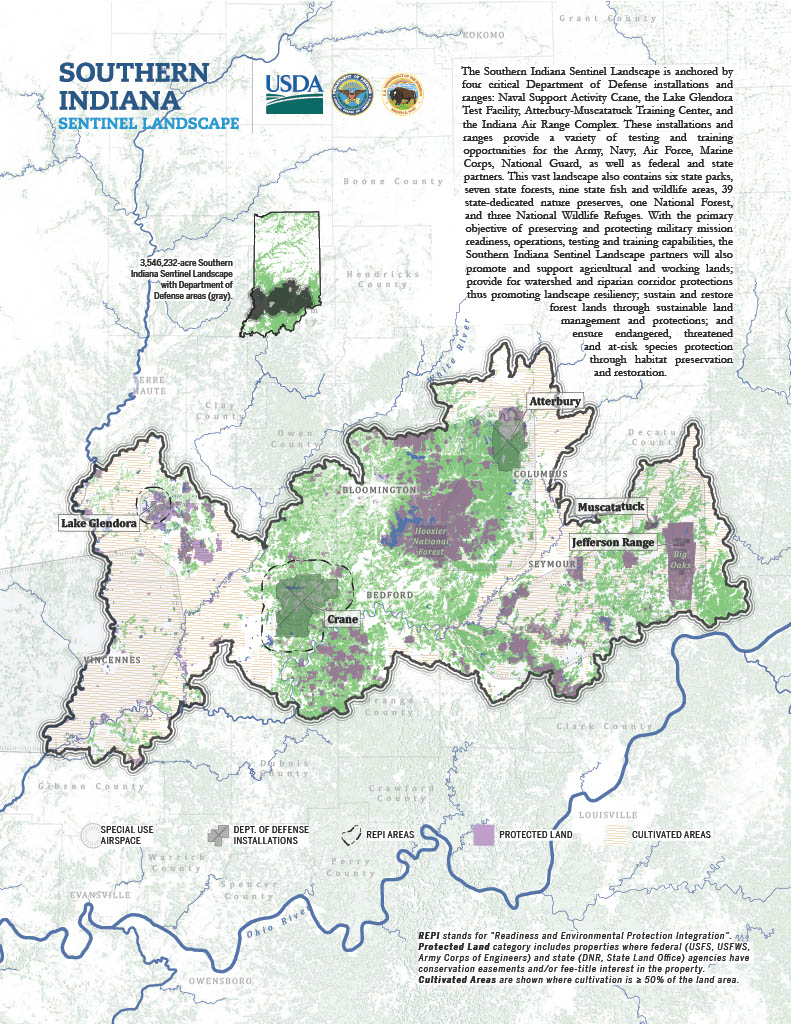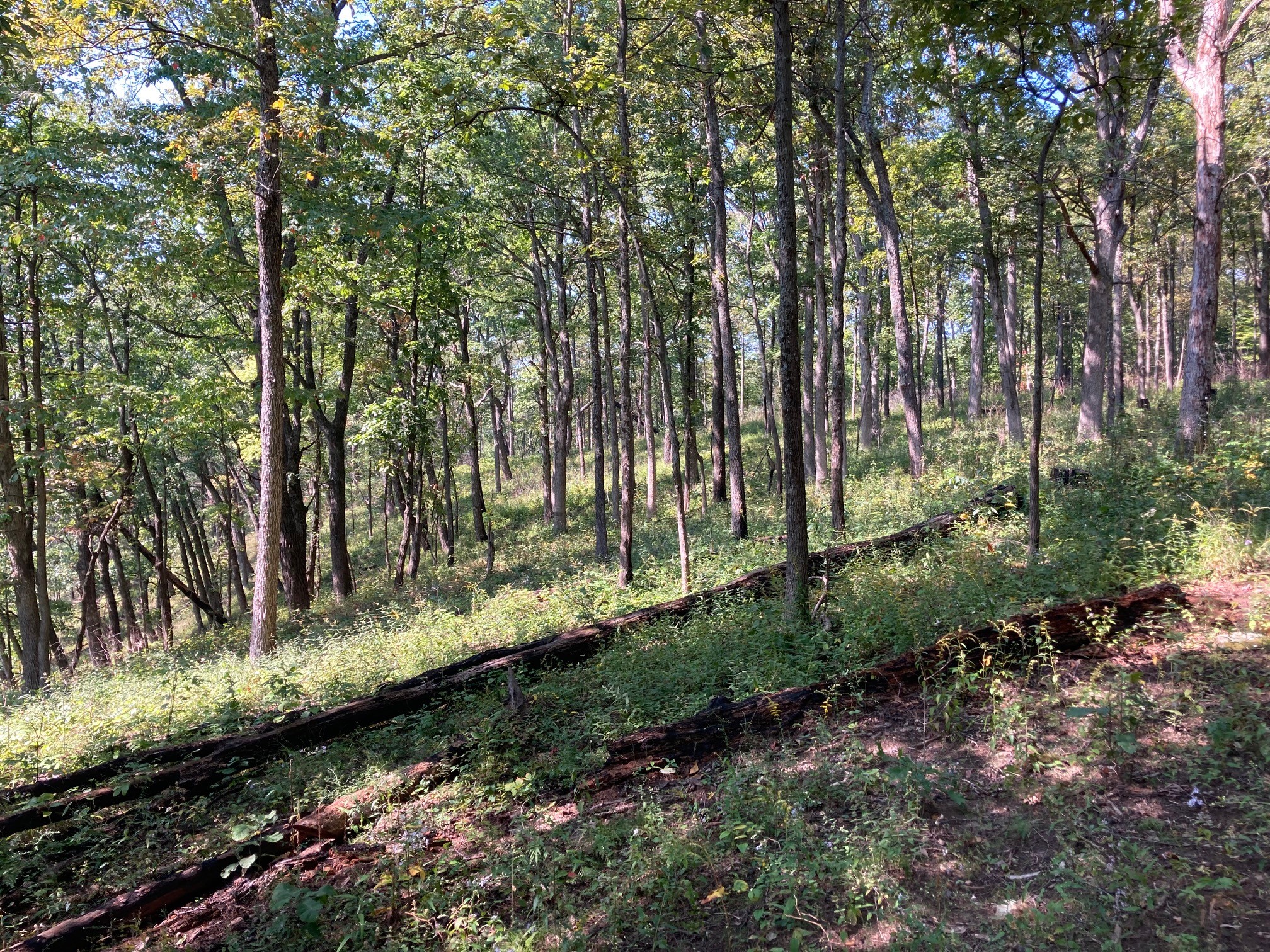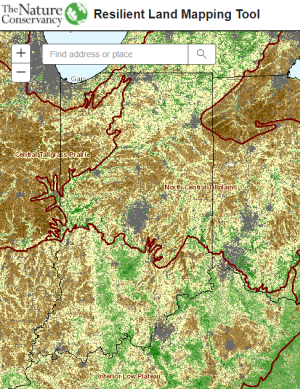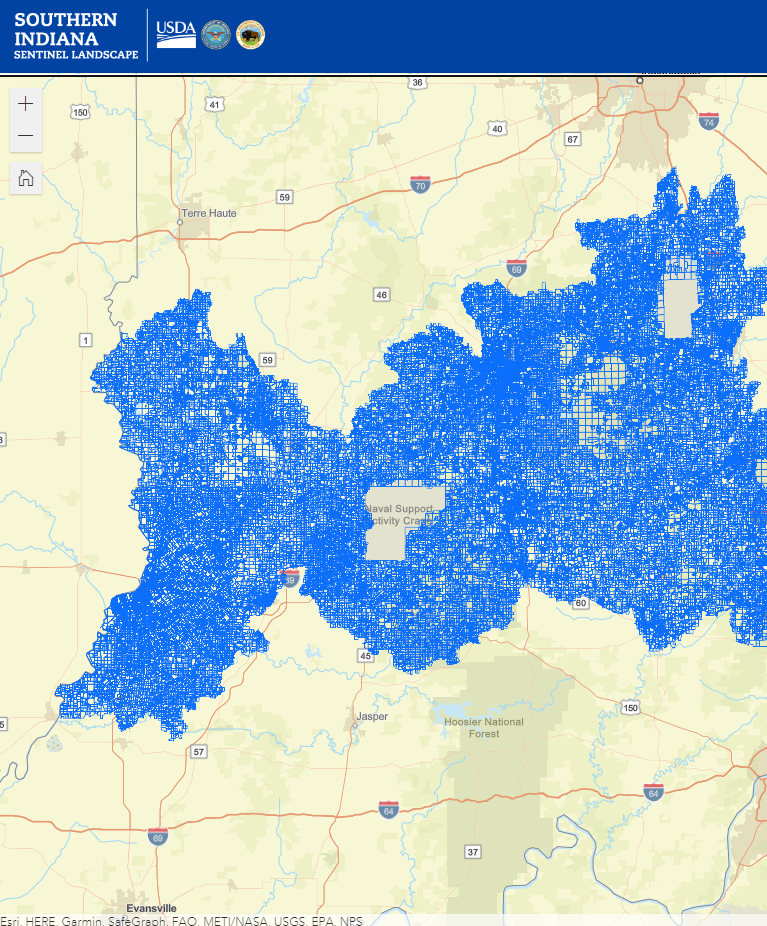Southern Indiana Sentinel Landscape
-
Indiana
-
Established 2022
About
The Southern Indiana Sentinel Landscape is anchored by four critical DoD installations and ranges: Naval Support Activity Crane, the Lake Glendora Test Facility, Atterbury-Muscatatuck Training Center, and the Indiana Air Range Complex. These installations and ranges provide a variety of testing and training opportunities for the Army, Navy, Air Force, Marine Corps, National Guard, as well as federal and state partners. This vast landscape also contains six state parks, seven state forests, nine state fish and wildlife areas, 39 state-dedicated nature preserves, one National Forest, and three National Wildlife Refuges. With the primary objective of preserving and protecting military mission readiness, operations, testing and training capabilities, the Southern Indiana Sentinel Landscape partners will also promote and support agricultural and working lands; provide for watershed and riparian corridor protections thus promoting landscape resiliency; sustain and restore forest lands through sustainable land management and protections; and ensure endangered, threatened and at-risk species protection through habitat preservation and restoration.
Map

Total Funding by Partner
| Partner | FY2022 |
|---|---|
| State | $1.18M |
| Private | $3.34M |
| DOI | $0.01M |
Total Acres Protected and Enrolled
| Acres Protected (Since Designation) | 640.00 |
|---|---|
| Acres Enrolled (During FY22) | 10622.00 |
Partnership Highlights

Sustainable Working Lands for Habitat, Resilience, and Recreation
Much of the land surrounding the Southern Indiana Sentinel Landscape installations is forested or agricultural. These natural and working lands provides an opportunity for partners and stakeholders to sustainably manage forests, build soil health and resiliency on agricultural lands, improve ecosystem health, and maintain areas compatible with the military mission. Within the first five years as a sentinel landscape, the Southern Indiana Sentinel Landscape aims to enhance forestland management including oak and hickory regeneration, reforestation projects, and invasive species removal; protect sensitive floodplains and wetland corridors; promote agricultural best management practices; and connect natural lands for habitat and recreation opportunities. Sustainable forestry and invasive plant removal projects decrease the likelihood of wildfires during drought conditions, while reforestation projects increase floodwater storage and reduce nutrient loads and sedimentation during heavy storms. In addition to improving landscape resilience by maintaining and connecting healthy forests, the project also addresses habitat needs of the federally endangered Indiana bat, federally threatened northern long-eared bat, hellbender salamander, and neotropical migratory songbirds among others. Combined, these efforts have the potential to mitigate the effects of existing encroachment threats or avoid them altogether.

Partnerships for Healthy Rivers and Watersheds
Southern Indiana Sentinel Landscape partners are building on years of successful collaborations focused on river and watershed protection. Protecting and enhancing rivers and their watersheds further improves landscape resilience. The ongoing Healthy Rivers Initiative, managed by the Indiana Department of Natural Resources, is one of the largest land conservation initiatives ever undertaken in Indiana. Through this initiative, natural resource agencies and organizations work with willing landowners to permanently protect land located within the Muscatatuck River and Wabash River floodplains. Implementation of regional watershed management plans, state and federal wetland and waterway programs, and perpetual easement programs will allow for improved resiliency and encroachment protections. These projects involve the protection, restoration, and enhancement of riparian and aquatic habitats with a focus on the species of greatest conservation need, including threatened and endangered, and declining migratory birds and waterfowl. These initiatives also benefit the public and surrounding communities by providing flood protection to riparian landowners and increasing tourism and public access to recreational opportunities such as hunting, fishing, hiking, and bird watching. In addition, best management practices on agricultural lands reduces nutrient runoff and increase resilience to droughts and flooding. Working with existing partnership projects and other riparian and watershed initiatives, the Southern Indiana Sentinel Landscape aims to promote water conservation within wetlands and floodplains by providing watershed and riparian corridor protections and waterway and wetland restoration.
Our Partners
Federal Partners
Other
- American Bird Conservancy
- Central Hardwoods Joint Venture
- Conservation Cropping Systems Initiative
- Conservation Law Center
- Friends of Lake Monroe
- Indiana Association of Soil and Water Conservation Districts
- Indiana Corn Marketing Council
- Indiana Forestry and Woodland Owners Association
- Indiana Prescribed Fire Council
- Indiana Soybean Alliance
- IU Environmental Resilience Institute
- Let the Sunshine IN (LSSI)
- National Wild Turkey Federation
- Radius Indiana
- Regional Opportunities Initiative
- State of Indiana Cooperative Invasives Management
- The Nature Conservancy
- White River Military Coordination Alliance
Resources
-

The Nature Conservancy Resilient Land Mapping Tool
-

Conservation Discovery Application
Meet the Coordinators

Michael Spalding
mspalding@sentinellandscapes.org
Michael Forest Spalding is the Coordinator for the Southern Indiana Sentinel Landscape with the Conservation Law Center in Bloomington, Indiana. Michael earned a Bachelor of Science in Forestry from Purdue University’s College of Agriculture in 2005. Since that time, he has performed conservation work in 55 counties throughout Indiana. He began his career as a field forester with a forestry consulting firm and has spent the past 15 years managing over 100,000 acres of public forests at Jackson-Washington, Yellowwood, and Morgan-Monroe State Forests as well as Atterbury-Muscatatuck Training Center. Michael brings a vast array of experience on both private and public lands in southern Indiana as well as a thorough knowledge of landscape-level threats to conservation and the work needed to restore the landscape.

Rob McCrea
rmccrea@sentinellandscapes.org
Rob McCrea is the Landscape Conservation Attorney at the Conservation Law Center. His practice focuses on land conservation projects in Indiana with a particular focus on the Southern Indiana Sentinel Landscape. Rob earned a Bachelor of Science in Ecology and Natural History from Prescott College and a law degree from Lewis & Clark Law School. Prior to joining the team at Conservation Law Center, Rob was in private law practice at McCrea & McCrea and also worked as the Land Preservation Director at Sycamore Land Trust in Bloomington, Indiana. Rob’s experience working with landowners on conservation projects and conservation easements will help implement key components of the Southern Indiana Sentinel Landscape.
“Ensuring Southern Indiana remains a safe haven for native species and conservation of natural lands is critical. This designation gives us important private and public sector tools and expands upon critical partnerships to protect lands, improve water quality, enhance climate resiliency, and preserve the beauty and splendor of Southern Indiana.”